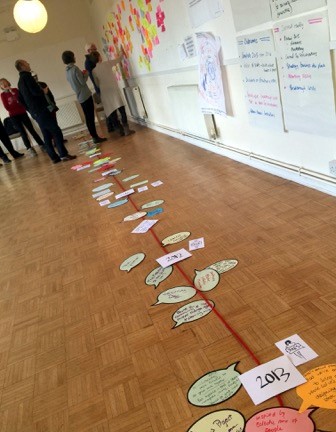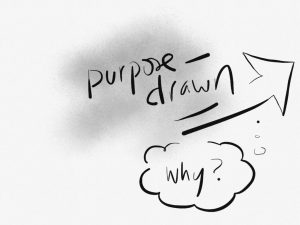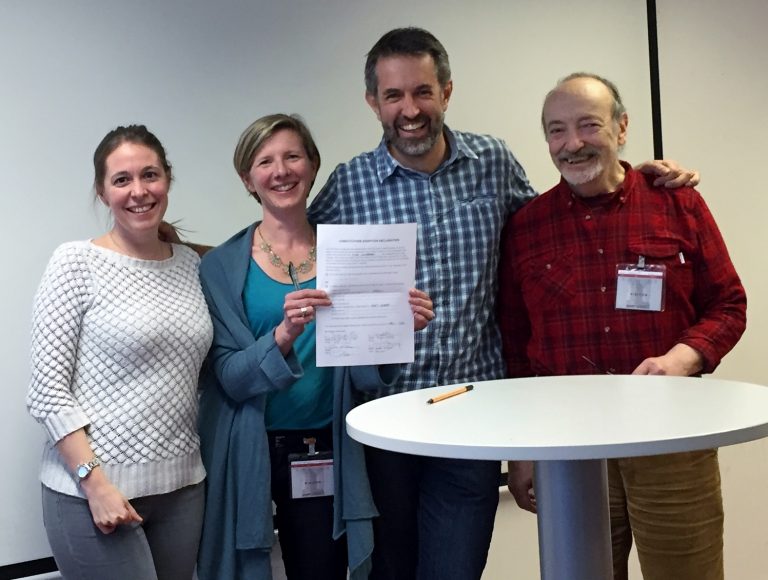Future Considerations turns 15
I am writing this on Future Considerations’ 15th birthday (February 2015). It’s quite a milestone for any organisation – and also for me personally, as I have journeyed (personally & professionally) with Future Considerations since its early days.
At our annual gathering in December, Bill Torbert shared his model of the successive Action Logics that organisations typically develop through. Just as many believe that children, leaders, and societies evolve through developmental stages, so do organisations. Frederic Laloux provides an excellent summary of these stages in Reinventing Organisations (read more here). As we explored Torbert’s theory, a reflection on our own path over the past 15 years seemed to validate it.
My hope in writing this post is to give you an insight not only into our own journey, but more importantly, give pause for you to reflect on the evolution of your own organisation, and what might be next along your developmental path.
 At that same December gathering, we built a timeline of our 15-year history, sharing each of our stories of key events and experiences along the path. What struck us was how, despite Future Considerations’ roller-coaster, the sense of purpose and values that ran through all of it was remarkably consistent, from day one. As the organization has grown and shrunk, morphed and transformed – as with most other organisations – there has been joy and reward, and there has been pain and sadness. We acknowledged all of this, and our facilitator, Sharon, suggested a ritual of accepting Future Considerations’ past as a way of moving boldly into our future.
At that same December gathering, we built a timeline of our 15-year history, sharing each of our stories of key events and experiences along the path. What struck us was how, despite Future Considerations’ roller-coaster, the sense of purpose and values that ran through all of it was remarkably consistent, from day one. As the organization has grown and shrunk, morphed and transformed – as with most other organisations – there has been joy and reward, and there has been pain and sadness. We acknowledged all of this, and our facilitator, Sharon, suggested a ritual of accepting Future Considerations’ past as a way of moving boldly into our future.
Incorporation Phase
My first exposure to Future Considerations was in late 2001, 6-8 months after its birth, when it was effectively a one-person organisation (with Paul Gibbons, as founder, at the helm) a big sense of purpose and compelling values and one or two small clients. Soon a loose grouping of associates gathered and, after Cari Caldwell, I became the third “partner” in the business. These were exciting times, filled with opportunity (a euphemism for some anxiety about where the next client would come from!) and a sense that we could build from a blank slate. We had many philosophical debates about approaches to leadership, organisational development, diversity and sustainability, and actively worked on our personal development. We developed the website, put together offers, and responded enthusiastically to client opportunities. Within the first year, some major client projects and some truly fulfilling and impactful work began to come in. Meetings were in the living room, or at the local Pizza Express with flipcharts draped over a chair, or, as we grew, at a rented room in a nearby monastery.
Experiments Phase
Within a year or two, we had moved through Torbert’s “Experiments” phase. We hired staff, rented office space, cooked up salary policies, and began to formalise decision-making mechanisms – all the normal moves that startups make as they “grow up”. While there was still quite a start-up mentality, we were moving more and more into the formalisation of an organisation. Paul, Cari and I were the three main partners and others were employed or associates, but we tried to involve everyone in building the vision and strategy of the organisation. Meaningful client work continued to flow and we developed some innovative approaches that are still at the heart of our offers today.
Orange/Achiever Phase
In about 2005, with around 8-10 full-time staff, we felt that the organisation was ready for its next stage of growth, and that we could do with outside help. Perhaps this was the dawning of our “Systemic productivity” era (in Torbert’s language), or as Laloux would characterise it, our Orange years. We hired a former corporate executive as our MD, and over the next 3-4 years, grew the organisation to 21 full-time staff.
There were many positives. Our growing credibility and scale meant that we secured some major new clients who remain a core part of our work to this day. We did great work with them, true to aspirations. But, like any stage of development, the positives came with a big shadow. Board and management meetings were very focused on the finances, and increasingly on the potential sale of the business. We had performance dashboards, innovation pipelines, complex contracts – and relatively less conversation about our purpose and values. While these concerns were alive and well – particularly in our client work – and we had not lost sight of the deeper purpose of the organisation entirely, this seemed a lot less present. We had become preoccupied with the Orange concerns of growth and achievement. And while the financial top-line of the business had multiplied, we were haemorrhaging money in the bottom line as we invested in offerings developed out of the dream of growth, scalability and pumping up the value of the business. As co-founders, I remember a moment when we turned to one another and said “when did we start working for Future Considerations, instead of Future Considerations working for us?”. We felt that we had started to feed the machine.
As one of our Gen-Y employees at the time, Jaroslav, put it in an email to us all:
“I assert the FC collective soul is nearly dead. It has been dying for a while now, right in front of our eyes… Individuals cannot prevail together where collective soul is dead. While all of us are making our heroic efforts and speaking up to ourselves and to each other, coming with creative ideas, sharing our frustrations and striving to be authentic, when we are all together … we all choose to be silent about the things that should be said … We run away to pursue our own projects because it became too painful to do things together. We are facing our clients advising them on authenticity, communication, empowerment, trust and supporting them to transform themselves in today’s difficult times, while at the same time we are running away from our offices to avoid the very same thing we advise others to change.”
As co-founders and other concerned leaders, we needed to act. We began a difficult process of separating from the MD we’d hired. He had been acting with the best of intentions, but we were simply not deeply enough aligned about the vision of the organisation. We arranged a 5-day all-company meeting in March 2009. We spent the bulk of that week “completing the past” – openly sharing our assessments of where we had lost our way, our disappointments in one another, and saying – often emotionally – what needed to be said. Largely freed from this baggage, we began, towards the end of the week, to re-create our purpose, values, dreams and new ways of working.
Paul, as original founder, courageously decided it was time to part ways. The business negotiated to buy 100% of the shares from the existing shareholders and for the members of Future Considerations to collectively own these. We didn’t want the interests of owners and of the core purpose of the business to diverge ever again. (As a footnote, it’s taken us some time to formalise the legal vehicle to embody this unusual approach to ownership, and are in the process of setting up an innovative “Trust” that will own Future Considerations.)
Green/Redefining Phase
If developmental shifts can be characterised by single events, this 5-day event marked the shift of our centre of gravity from Orange to Green, or in Action Logic language, from Achiever to Redefining. Of course, there had been a tussle between Orange and Green all along, and earlier and later stages of development were at play throughout.
And, like our development as leaders, the change was both sudden and gradual. Over the year or two that followed, we invented new ways of organising and relating that were far more sourced from our purpose and sense of mutual respect, and far less focused on financial drivers as a primary outcome. Some people left, perhaps fearing for the security that this new structure would provide. But work continued to flow, and in fact greater profitability returned as we moved to a more flexible models. We wrote a new “democratic” constitution and defined different “levels of belonging”. Our stated intention was never to focus again on building the business for sale, but rather to put our primary focus on our impact in the world and with our clients.
We moved all client-facing staff off the payroll. While this is crazy from the Orange perspective of maximising the saleable value of the business – you want to “own” your staff and IP – when we focused on our impact in the world it made perfect sense. Never again, we told ourselves, did we want to feel pressured to compromise on job staffing decisions “just to make the numbers work”. We wanted our purpose, and maximising our impact on clients, to come first, and this necessitated building a looser ecosystem of fellows, associates and partner organisations that we could form into different constellations to deliver what was needed.
This was a liberating move, as we “outsourced” the headaches of profitability and cash-flow to the individuals rather than holding them centrally! But it brought with it new challenges – how do you build a cohesive core when people aren’t paid just for showing up? We had to invent new mechanisms of communication, shared learning, reward, ownership, decision-making, staffing, knowledge sharing, quality assurance, etc. We began to use regular learning days, annual gatherings and online spaces to connect people, and the purpose and values became a uniting factor in attracting and keeping people who shared our DNA. We were clear that we didn’t want to be a “rolodex organisation”, but still very much to have a strong core of people who are building something together – albeit without fixed salaries and with other commitments outside of Future Considerations.
In this transition, the shift wasn’t from the depressing “now we work for Future Considerations” back to “Future Considerations works for us” – it was forward to “Future Considerations works for our shared purpose”.
But like all stages of development, there has been a shadow. The metaphor Laloux gives to organisational life in Green is “family”, and the egalitarianism and inclusion in Green/Redefining has been a challenge. As we’ve flattened out the organisation and focused on building the strong community vital to our work, decisions beyond client projects can be bogged down with a need for consensus or inclusion, and tough calls and bold moves that would maximise our impact can be hard to make.
During our December workshop with Bill Torbert and Elaine Herdman, we agreed that Green/Redefining was our centre of gravity, and there was a need to transcend this to embody Teal/Transforming. This tussle has been alive and well for years – just as the 2006-2009 period was characterised by an Orange/Green tension, so the recent years have been characterised by Green/Teal differences.
Teal/Transforming Phase
It does feel that we’re emerging to a more consistently Teal-Transforming place in how we work. While aspects of Teal have always been present, there is a growing feeling of this describing us. Laloux’s three breakthroughs – Evolutionary Purpose, Wholeness and Self-Management – have been a big focus for us: in how we think about ourselves, and increasingly, in our client work. We’re getting feedback that there is more velocity and agility, greater impact, and greater freedom for individuals to organise and unlock resources for the work they feel is most on-purpose. As we grow rapidly as an organisation, we’re realising the limitations of Green and building ways that support that growth to be an expression of our purpose rather than a distraction from it.
We are moving to Holacracy as an organisational operating system, in the hope that this will provide some of the scaffolding we need. We hope it will provide the transparency and clarity that will enable people to quickly channel their energy to where it makes the biggest difference; to embody the healthy hierarchies of Teal sometimes absent in Green; and to encourage all of us to move beyond the personal and the ego to what matters most in the midst of volatile times. We will be paying attention to how we can retain and enhance a sense of wholeness while moving to this more tightly-structured way of working. It’s an experiment – no doubt not our last – but one that after a lengthy process of dialogue we signed up to unanimously.
We always remind ourselves – as we have to remind clients aspiring to “go Teal”, that it is neither necessary nor likely that all of the organisation’s members will operate from Teal for the organisation to centre there. Our incredible journey over the years has been massively helped by having the healthy aspects of all the developmental stages alive among us, and I hope this will continue. My own journey over these years has been about both stretching myself in my development to later stages, and rounding out the steps I may have rushed along the way. We always say that we can only take clients as far as we’re able to go ourselves, so hopefully our journey will not end.
When someone writes the 20th birthday blog post of Future Considerations, it will be interesting to hear how the latest experiment went.
Mark Young is a coach, consultant, facilitator, experienced learning designer and Fellow of Future Considerations.




Hi Mark – this is really interesting. A fascinating insight into your organisational journey. Thanks for sharing!
A lovely blog, really thought provoking. Making me think about how interacting with a organisation so consciously aware of its own development must impact on client organisations and their members and what this experience has been for me.